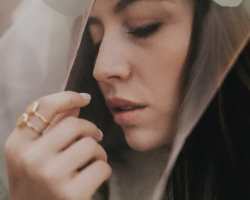The hallmark of Indian women is a red point on the forehead. This symbol is called Bindy, and it refers to religious signs.
Content
- Why Indian women put an end to the forehead between the eyebrows: Bindi's features
- Why Indian women put an end to the forehead between the eyebrows: Sindur and its features
- Why Indian women put an end to the forehead between the eyebrows: the value of the Holy Hindu Tilak
- Video: The value of the point on the forehead of Indian women
Back in the 20th century, it was actively used by women of India, and now a small number of Indians adhere to religious traditions. At the present time, the red point on the forehead of women is only an element of makeup. This article will tell you why women India are applied to Bindy, and what this sign means.
Why Indian women put an end to the forehead between the eyebrows: Bindi's features
- Translated from the Indian language, Bindy means "drop." This sign can be attributed to sacred signs, because he is one of the types of Tilak. It is often called a "symbol of truth." Apply a point on the forehead between the eyebrows. In Hindu culture, it is believed that there is a third eye.

- Bindy should apply only girls who got married. They must also cover the parting on the hair with red powder. The first time they apply girls sindur (red powder) during the wedding. This ceremony is officially called "Sinduradan." The young man should apply red powder with his bride, and in the process to pronounce a wedding oath.
- Unfortunately, it is impossible to say now when this tradition first appeared. In Hindu culture red color is considered the personification of power. The powder, which is applied to the parting of the hair and to the area between the eyebrows, will give the woman the blessing of the two goddesses - Sati and Parvati. The first goddess will help the girl become the guardian of the hearth. Parvati is the goddess of happiness. She will bring to the house an understanding between the spouses, and also give them children.

Other values \u200b\u200bof Bindy
- The most basic value of the point on the forehead between the eyebrows is the marriage of a woman. But, in addition, there are other meanings that also have the right to exist. According to tantric exercises, bindy is a symbol of wisdom.
- Some scientists believe that Bindy retains energy and wisdom a person that arise in the process of thinking. They move from the spine to the head with the help of an Ajn chakra, located in the central part of the forehead. There is an opinion that Bindy is capable of protect a woman from negative energy and evil spirits.
If you carefully look at the shade of the point, you can understand which caste the woman belongs to:
- kshatriy
- red - Brahmans


In some women, you can notice a point on a yellow forehead. She has several interpretations - either the girl has died in her family, or in her family lasts mourning.
Why Indian women put an end to the forehead between the eyebrows: Sindur and its features
- Now the point on the forehead between the eyebrows is applied with different materials, but, the most common option - sindur. This is ordinary a bright red shade powder.

- Its pigment is exactly transferred to the skin, and lasts quite a long time. Sindur is obtained from mercury material (cinnabar) or a sword beard. The powder is actively used in Hinduism.
- It is necessary to apply the tip of the finger. But, first you need to train a lot, because the point should be without flaws. For convenience, you can use a coin with a hole or a hollow disk. With wax, glue a coin or a disk to the forehead, fill the hole with a single. After the disk can be removed, and the point will turn out with an ideal circle.
In addition to Sindur, you can use other materials:
- bull blood
- abirwhich needs to be mixed with yogurt and rice flour
- turmericmining from turmeric. It is mixed with lemon juice
Why Indian women put an end to the forehead between the eyebrows: the value of the Holy Hindu Tilak
The value of this jewelry can be different, depending on the religious direction of Hinduism:
- Followers of Vishnu apply tilac two vertical stripesthat are connected between the eyebrows. By this, religious people attract the location of the deity.
- The rocket-chandana is applied using sandalwood pasta. Such tilac is applied by people who worship the god Ganeshi.
- Tripundra. It is applied to the form of three horizontal lines.
- VIRA-YILAK The winners in the game or war are inflicted.
- Raja Yalk Households are applied if they accept respected guests or participate in coronation.
- Followers madhwan-Sampradai Apply to Sindura in the form of two vertical lines. By this, they have the god Krishna to themselves. If a person spends fiery sacrifices daily, he must put an end to the dark ash between the lines, which is received after the victim.
- Shakta followers apply tilac in the form of a red point or line. They use it turmeric.

So, now you know why Indian women apply an end to the forehead between the eyebrows. Despite the fact that the symbol has almost lost religious meaning, some girls try to adhere to ancient traditions. In European countries, this sign belongs to exotic marks. He became an integral part costume parties and masquerades.
We will also tell you why:
- Steal the bride at the wedding
- Put the stigma of the puppies
- The girl is married
- Need a little pocket on jeans
- The bride to cover his face with a veil







